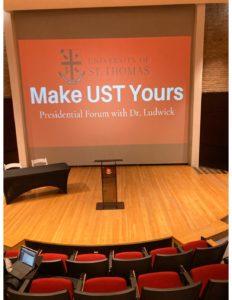Proposed changes to the Student Organization Committee structure could reduce or even eliminate student leader stipends, and student activity fund allocations will be handled by an independent treasury committee instead of the Student Government Association, according to SGA President Greg Pirolli, a UST graduate accounting major.
The changes will begin to be implemented after general elections at the start of the 2019-2020 school year and are part of a structural overhaul of SOC that will help accommodate the anticipated growth of the student population outlined in UST President Richard Ludwick’s “Call Toward Tomorrow” plan, according to Assistant Dean of Students Amanda Villanueva. SOC organizations include the Student Government Association, Student Activities Board, Sports Club Association, the Council of Clubs and the Graduate Student Association.
The SOC structural changes are based on a model presented by Dean of Students and SGA adviser Lindsey McPherson. According to McPherson, the model is a mixture of ideas that have been discussed among SOC leaders and their advisers in special bimonthly meetings.
“I have just been sort of taking notes and trying to listen to what everybody wants and what everybody is doing,” McPherson said. “I wouldn’t really say it’s my model; it’s based on what everybody is saying.”
Villanueva said that as the changes are implemented, it will be the responsibility of the chief justice of the judicial council to oversee them and voice any problems or concerns that need to be addressed and fixed in the model.
“We know there are going to be big changes next year, slight or major we don’t know,” Villanueva said. “It’s not just a one-and-done and move on, but there’s also going to be a student [the chief justice] dedicated to looking at this [the structure] to make sure it still makes sense.”
According to SGA Vice President Rosa Sotelo, the changes will not be implemented all at once. She said SOC executives discussed a “transition model” whereby changes will be made in increments so SOC members are not overwhelmed. She also said further discussions will be held about the transition model and the new structural changes in SOC executive meetings and among all SOC members.
Villanueva said open forums will be held during the first week of the 2019 spring semester, so students can ask questions, voice concerns and learn about the proposed structure. Then, general elections will be held so students can vote on the changes.
“It’s going to be quick, it has to be quick,” Villanueva said. “Otherwise, the old election code kicks in and we’re married to the [current] structure moving into next year.”
Pirolli said 25 percent of student activity funds, about $60,000, is currently allocated to student leader stipends, and SOC executives are hoping to at make significant cuts to those stipends. Pirolli said that even without a stipend, a student leadership position will look attractive on resumes, and that the value of these positions will be seen in students’ future employment opportunities.
Cutting student leader stipends would be a huge cost-saver, Villanueva said. All monies will go to a treasury committee, which will allocate funds to current student organizations and two new proposed organizations, Diversity and Campus Initiatives. She said any remaining funds could be used for new projects and other initiatives from student organizations.
However, she also said that student leaders who are already receiving stipends will continue to receive them until the end of the 2019 spring semester.
“All the students [with] stipends– they were guaranteed it coming into it,” Villanueva said. “We’re not going to pull the rug out from under them, because some of them are depending on that money.”
Pirolli said one of the biggest changes to the old model is that the Senate will no longer be responsible for allocating money from student activity funds to SOC organizations. Currently, student organizations present budget reports and proposals to SGA outlining events they want to hold, along with a spending estimate. SGA then votes on the allocations.
Pirolli said in the past, members of other student organizations complained about the allocation process and accused the Senate of having a conflict of interest, because under the current system, any money left over after allocations remains at the Senate’s disposal.
McPherson said SOC organizations accused Senate members of not understanding the functions of the organizations and called SGA “power hungry.”
“I’m not really sure if there was any truth to that kind of stuff,” McPherson said. “It just caused a lot of animosity amongst our students and it just wasn’t going in a good direction.”
Villanueva said a conflict between SGA and student organizations last year led her to propose a change in the allocation process. Student organizations accused the Senate of violating the constitution by holding a closed meeting where allocations were discussed, an accusation that the judicial council agreed with, because the constitution stipulates that all allocation meetings must be open to the public. Closed meetings mean anyone outside of SGA, including SOC advisers, must leave the room, Villanueva said.
Consequently, the allocations awarded by the Senate at that closed SGA meeting were overturned and all organizations received the amount of money they originally requested, Villanueva said.
“Everybody was upset with how the allocation process went last year,” Villanueva said. “Every single person who went through it said ‘this was ugly.’”
Biology major and sophomore senator Youssef Ahmed is one of only two senators who voted against the proposed model in a recent SGA meeting. Ahmed said he felt the model and the changes were rushed and too general.
Ahmed said SOC executives should have shared the idea of the new structure at least a year earlier to lessen the stress the changes are putting on senators.
“It’s overwhelming,” Ahmed said. “Even though it seems sound in theory, looking at all of it at once is very stressful.”
He said that right now, changes made to the proposed model are not communicated to SGA senators right away. Most of the discussions are held in the SOC executive meetings, where senators are not present, and he said he feels this creates a disconnect between senators and executives.
“I feel like it is a problem because not all the senators are informed,” Ahmed said. “We have a limited amount of time to actually realize what’s happening and come up with questions and play devil’s advocate as to how things could go wrong.”
However, Ahmed said the proposed treasury committee will solve many of the allocation issues and save a lot of time, because the current process takes too long.
“We’re having conversations about very superficial things and ultimately waste time,” Ahmed said. “I think it’s a good idea to hand [allocations] off to another committee so that Senate can do what it’s meant to do, like actually improve student life.”
Pirolli said the proposed treasury committee will require its members to not be affiliated with the executive branch and SGA, but said committee membership criteria are still being discussed.
“There’s going to be a place where we need to draw the line,” Pirolli said. “I’m not quite sure where that line is going to be, but it’s something we’re going to have to figure out.”
According to SGA Parliamentarian Joseph Nemec, treasury committee members would be appointed by the vice president of the treasury committee, who will be elected by students.
Sotelo said another proposed change to the SOC structure is that SOC organizations will be governed by vice presidents answerable to the student body president going forward. The Senate, the Treasury, Traditions, Campus Initiatives and Diversity will all have their own vice presidents. She said the current presidents of SOC organizations will transition into these positions, and new vice presidents for Campus Initiatives and Diversity will be elected during general elections. All of the vice presidents will fall under the student body president, who will be elected by the student body during general elections, Sotelo said.
“We really like the idea of having this VP model because we believe it’s going to unify the SOCs,” Sotelo said.
However, SCA and COC will become the Office of Recreational Sports and Office of Student Activities, respectively, and will become separate organizations from the SOC according to the proposed model.
Villanueva said, originally, she and other SOC executives only discussed changes to the allocation process. After she proposed the changes to President Ludwick, she said he told her to look at SOC from a broader perspective and consider changes to the overall structure to accommodate the student population growth outlined in the CTT plan.
“[The old allocation process] was a symptom of how the larger organization didn’t work,” Villanueva said. “Our current structure can’t accommodate that 5,000 [students] goal. It’s really a broken structure.”
Villanueva said she will collaborate with the office of marketing communications to post information about the structure changes on the CTT website so students can familiarize themselves with it. Villanueva did not specify when this would happen, but said it would occur before the 2019-2020 school year.





Be First to Comment